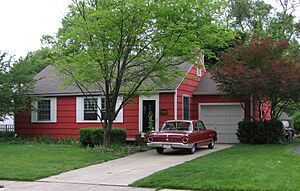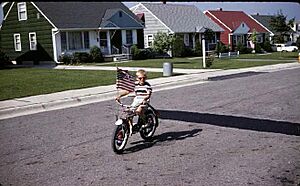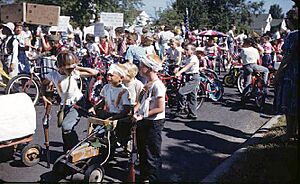Colonial Hills facts for kids
Colonial Hills is a neighborhood with 873 homes in Worthington, Ohio. Worthington is a town just north of Columbus, the state capital. This community was built by the Defense Homes Corporation. They needed homes for workers during World War II and for families after the war. Colonial Hills is still a lively neighborhood today.
Contents
History of Colonial Hills
Colonial Hills was built in the early 1940s. But people had plans to build homes here much earlier, in the 1920s. The U.S. government got involved because of the huge need for housing during World War II. This helped the project finally become real.
Early Plans for Homes
The land where Colonial Hills stands today has a long history. In 1787, the U.S. Congress created the Northwest Territory. This large area included what would become Ohio. Later, in 1796, land was set aside for veterans of the American Revolutionary War.
In 1797, a man named Israel Ludlow surveyed this land. He divided it into large sections called townships. Colonial Hills was in Sharon Township. In 1803, the town of Worthington was settled. The land for Colonial Hills became a farm. It stayed a farm until 1942, when houses started to be built.
The first plan for a neighborhood called Colonial Hills was made on October 11, 1927. A company called Jennings-Lawrence Company drew up the plans. This first plan included only a few streets. These plans were put on hold for a long time.
Then, on February 18, 1940, a model home was opened. It was at 36 East Southington Avenue. This home was part of a show in Columbus. But because of the Great Depression, most people didn't have enough money to buy new houses. So, the building project stopped again. The homes the government built in 1942 were much simpler than this model home.
Designing and Building the Homes
A young architect named Todd Tibbals designed the homes. His office was in downtown Columbus. He created nine different styles of homes. These styles were used for the first 200 houses. The whole project was planned to cost $1,250,000.
The houses were built in a special way. Parts of the homes were made in a factory. Then, they were brought by train to a lumber company. From there, trucks carried the pieces to the building site. This made building much faster.
To save time and money during the war, the U.S. Government used a product called sheetrock. Before the war, walls in American homes were usually covered with plaster. Plastering took weeks to do. Sheetrock was much faster to install. Colonial Hills was one of the first places in the country to use sheetrock instead of plaster.
Building was going strong by January 1942. There were 400 workers on the site. By October 1942, two homes were ready for people to look at.
Old Rules About Who Could Live There
When the plans for the neighborhood were made in 1938, there was a rule in the property deeds. This rule said that only people of the "Caucasian race" could own or live in the homes. It also said that other people could only be there as servants.
This rule was put in place before the government got involved. But it was not removed even when the government took over the project. However, this type of rule was made illegal later. The Federal Fair Housing Act of April 11, 1968, stopped these kinds of restrictions. This means that today, everyone has the right to buy or rent a home, no matter their background.
First Families Move In
Because of the fast building methods, homes were finished quickly. By spring 1943, 58 of the first 200 homes were ready. Colonial Hills was built like an assembly line. This was even before Levittown, another famous fast-built community.
During the war, the homes were rented out. Many people who lived there worked at the Curtis Wright Aviation Plant near the airport.
After World War II
After the war, all the homes were sold. They cost between $6,000 and $8,000. Many were bought by the people already living there. Others were bought by returning veterans. Some homes were bought by investors and continued to be rented out.
Because so many people needed homes after the war, more houses were planned. An additional 645 lots were added to Colonial Hills. Building continued into the early 1950s. Many of these newer homes had two stories and basements. This made Colonial Hills much bigger. It grew to over 800 families, with about 3,100 people living there.
Joining Worthington
Around 1946, the Colonial Hills Civic Association was started. This group helped the community. In 1952, some people in Colonial Hills wanted to join the village of Worthington.
The area around Colonial Hills was changing fast. Farms were becoming stores and new neighborhoods. Both Columbus and Worthington wanted to add this valuable land to their cities. It was a big decision for Colonial Hills residents. They had to choose between staying in the township or joining Columbus or Worthington.
Many people in Worthington were worried about the cost of providing services to Colonial Hills. But after two years, on November 2, 1954, Colonial Hills officially became part of Worthington. This made Worthington's population grow to over 5,000 people. Because of this, Worthington changed from a "Village" to a "City." The Colonial Hills Elementary School was built soon after, opening in 1955.
From the 1950s to the late 1970s, Colonial Hills had a big Fourth of July celebration. It was a major event for the north side of Columbus. There was a parade with hundreds of children, floats, and horse-drawn wagons. The parade went to Selby Park, where tents were set up. Fireworks followed at Indianola Park.
Building Major Highways
Before the big highways Interstate 70 and Interstate 71 were finished across Ohio, Columbus started building "expressways." These roads would connect to the new Interstate System.
The part of Interstate 71 that runs along Worthington's eastern side was called The North Freeway. It cost $13.8 million to build. It reached 11th Avenue by August 1961. By August 1962, it reached Fifth Avenue. It finally reached downtown Columbus in November 1962. The entire I-71 between Cincinnati and Cleveland was finished in 1966.
I-270, also known as the Outerbelt, was planned in the early 1960s. The original idea was to build the northern part through a school. But people living nearby fought against this plan. In October 1961, after many letters from residents, the governor announced the freeway would be built north of Worthington. The first part of the Outerbelt opened in August 1967. The entire Outerbelt was finished in August 1975. It cost $150 million.
State Route 315 was another important highway. Its construction was not finished until 1981. Building it involved moving the Olentangy River in some places.
Colonial Hills Today
Today, most of the original homes in Colonial Hills have been updated. Their value has gone up a lot. The total value of just six Colonial Hills homes today would be more than the $1,250,000 it cost to build the first 200 homes. This shows how well the Defense Homes Corporation planned the community over sixty years ago.





